AI Agent Builders: Empowering A World of Automation
Hephaestus created Talos to guard Crete, Da Vinci had his mechanical knight, and de Vaucanson built a “digesting duck,” an automaton that could eat, flap its wi...
Hephaestus created Talos to guard Crete, Da Vinci had his mechanical knight, and de Vaucanson built a “digesting duck,” an automaton that could eat, flap its wings, and, well… do other duck things. Today, we’re in the era of AI agents, and you can build one in minutes with AI agent builders.
Ok, but what exactly are AI agents?
In a nutshell, agents (or AI bots) are small programs that can perform tasks like generating content or collecting data autonomously. The concept has been around since the early days of computing, but it has recently gained momentum with a new breed of large language models (LLMs) like GPT-4.
This article will teach you how to build your own AI agents in Taskade. You'll also learn how to train them to "think" like you, so you can relax and enjoy your coffee while agents do the heavy lifting. ☕️
💡 Here's a tl;dr of what we 're going to discuss
Basics of AI agents and AI agent builders.
Components of AI agents like memory, knowledge, and skills.
Process of building, training, and deploying agents.
Benefits of integrated AI agent builders.
Impact of AI agent builders on a and individuals.
🦾 What Are AI Agent Builders?
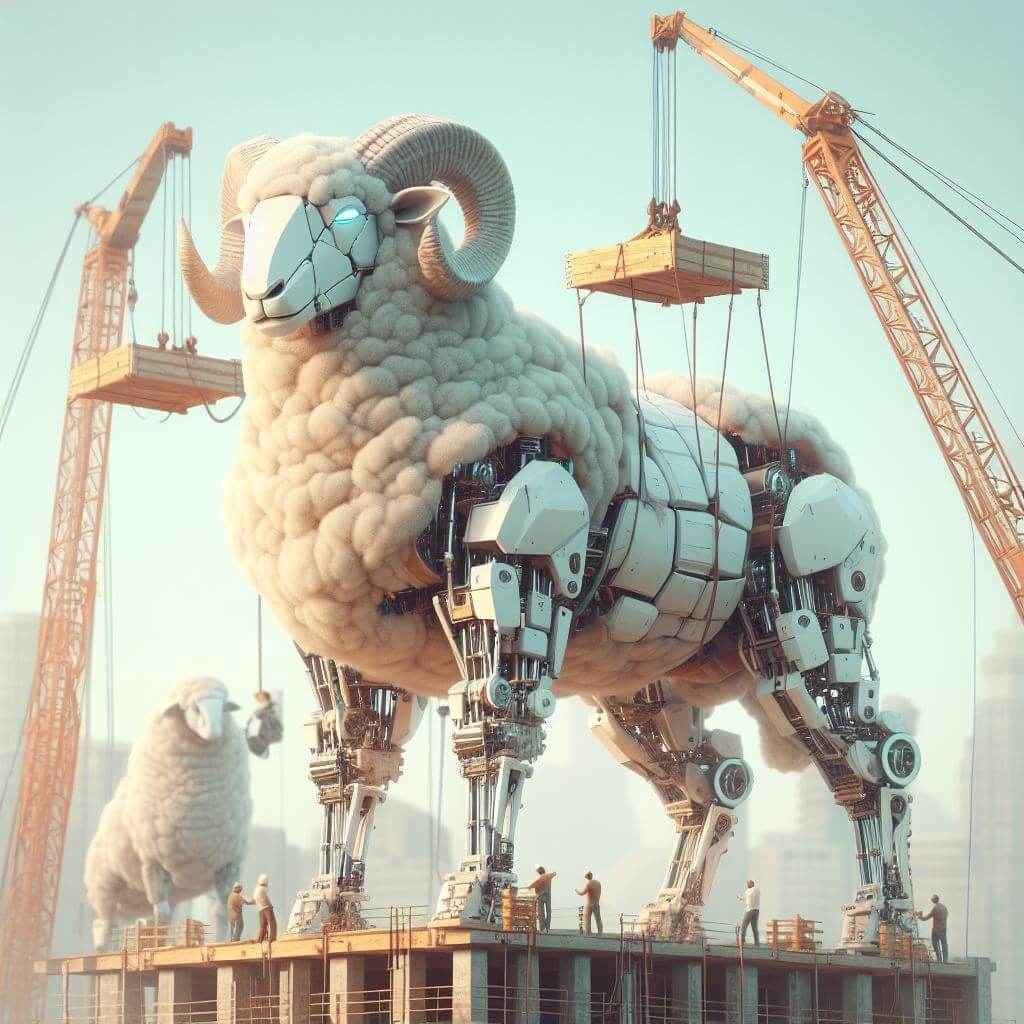
Chat-based generative AI tools like ChatGPT or Bing are cool. But they work on a mostly ad-hoc basis. You formulate a problem, ask a question, and get a response. Simple.
But what if the problem comes up frequently or you need to perform certain tasks on a daily basis?
This is where AI agent builders come into play.
An AI agent builder is a standalone or integrated platform that lets you build, train, and deploy customized agents without technical know-how. And it's way cooler than it sounds.
An AI agent is made up of several components:
🧠 Short-term and long-term memory that stores the context of tasks it's working on.
💡 General knowledge of the large language model (LLM) that powers the agent.
👹 A unique "personality" and tone of voice that's reflected in the agent's responses.
🛠️ A set of specialized skills, e.g. the ability to browse the web.
AI agent builders give you full control over the nitty-gritty of your assistants. You decide what tasks they specialize in, how they respond to questions, and how much they know.
Of course, there is much more happening behind the scenes. But the whole point of agent builders is to seamlessly integrate autonomous task management into existing workflows.
🐑 + 🤖 Introducing Taskade as an AI Agent Builder
Taskade is a productivity platform that blends project management features with smart tools powered by advanced AI. It's also the only solution with fully integrated agent-building capabilities.
(psst... that's Taskade down below. Isn't that a thing of beauty? 🤩)
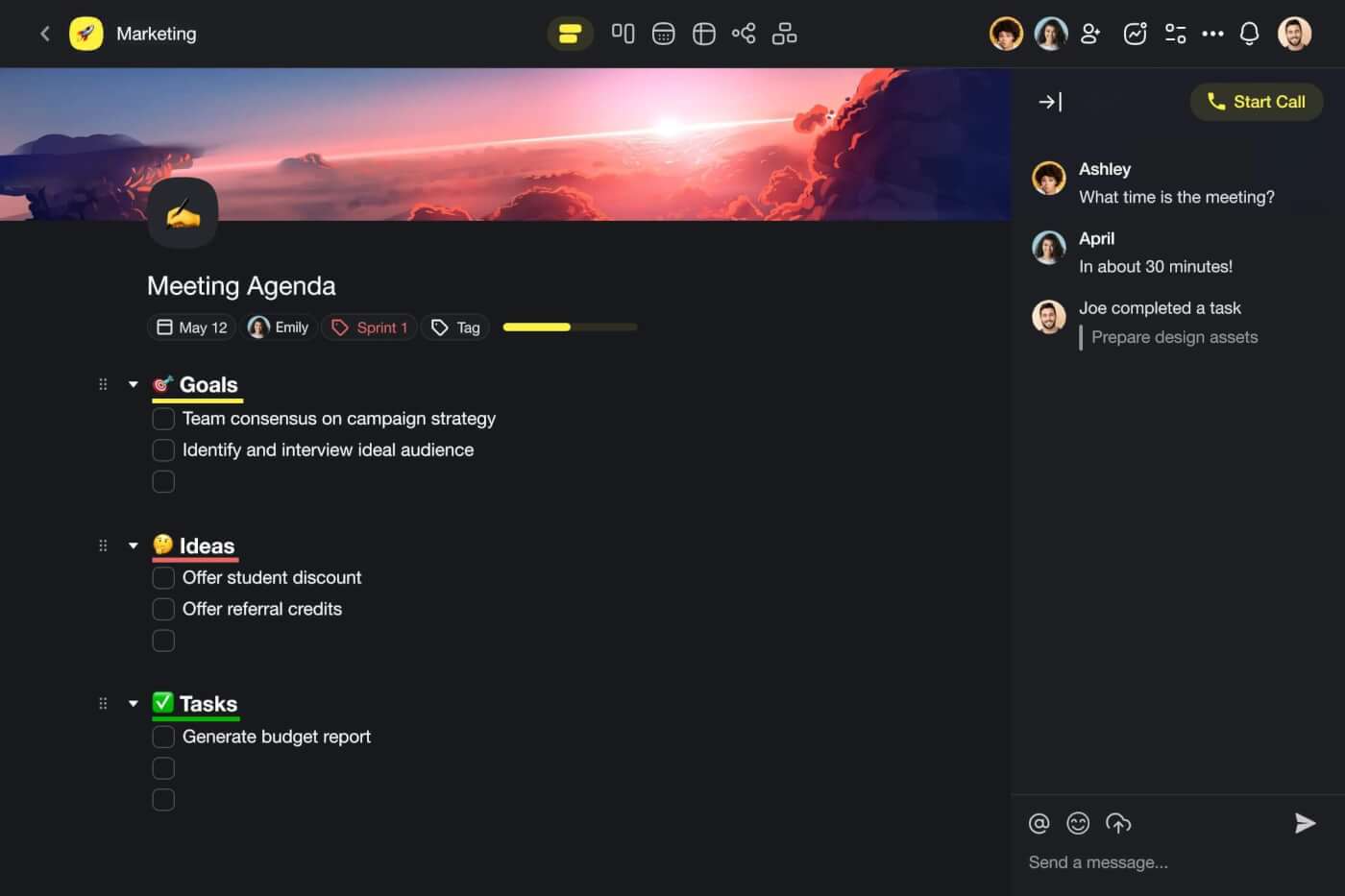
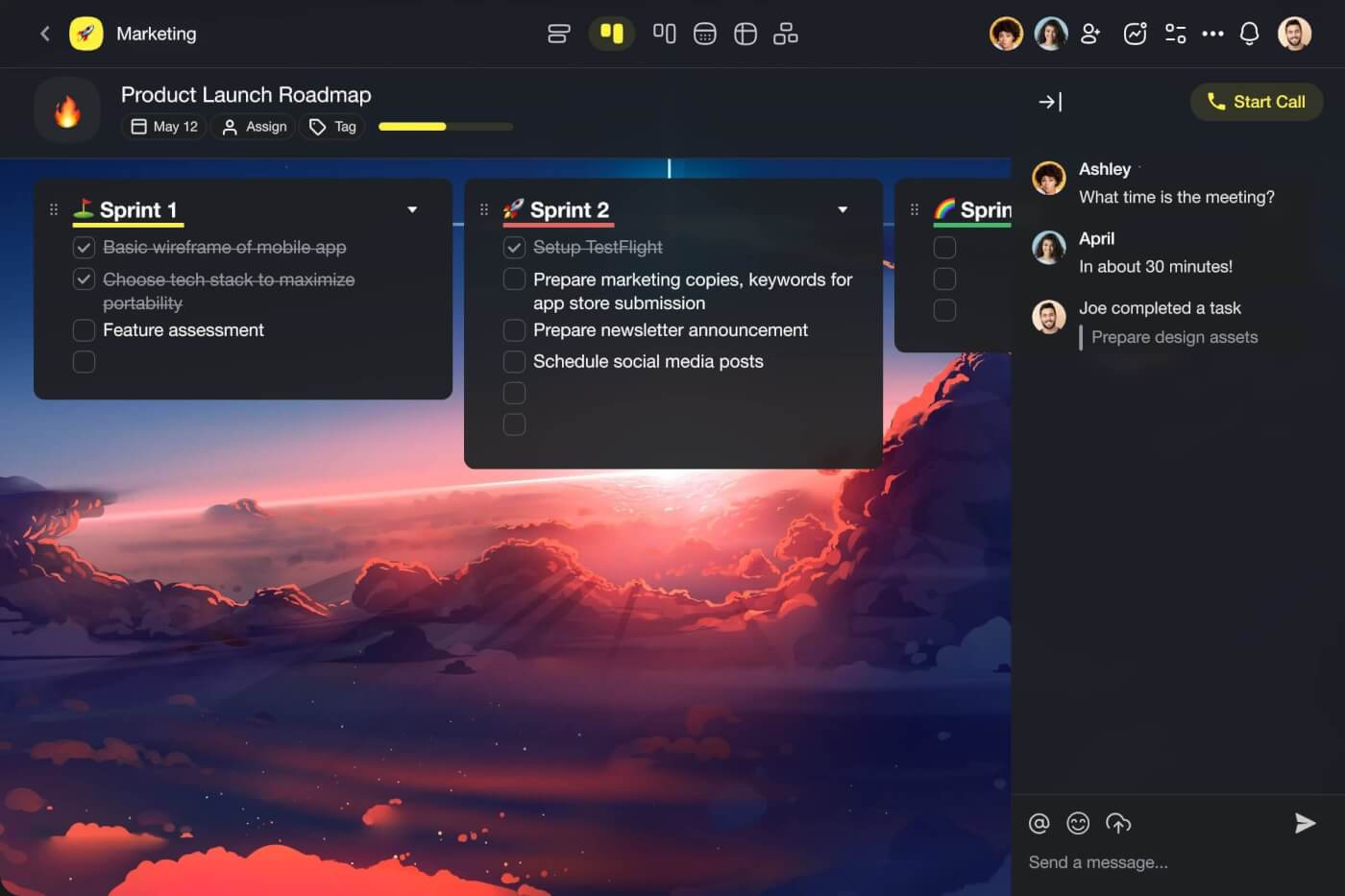
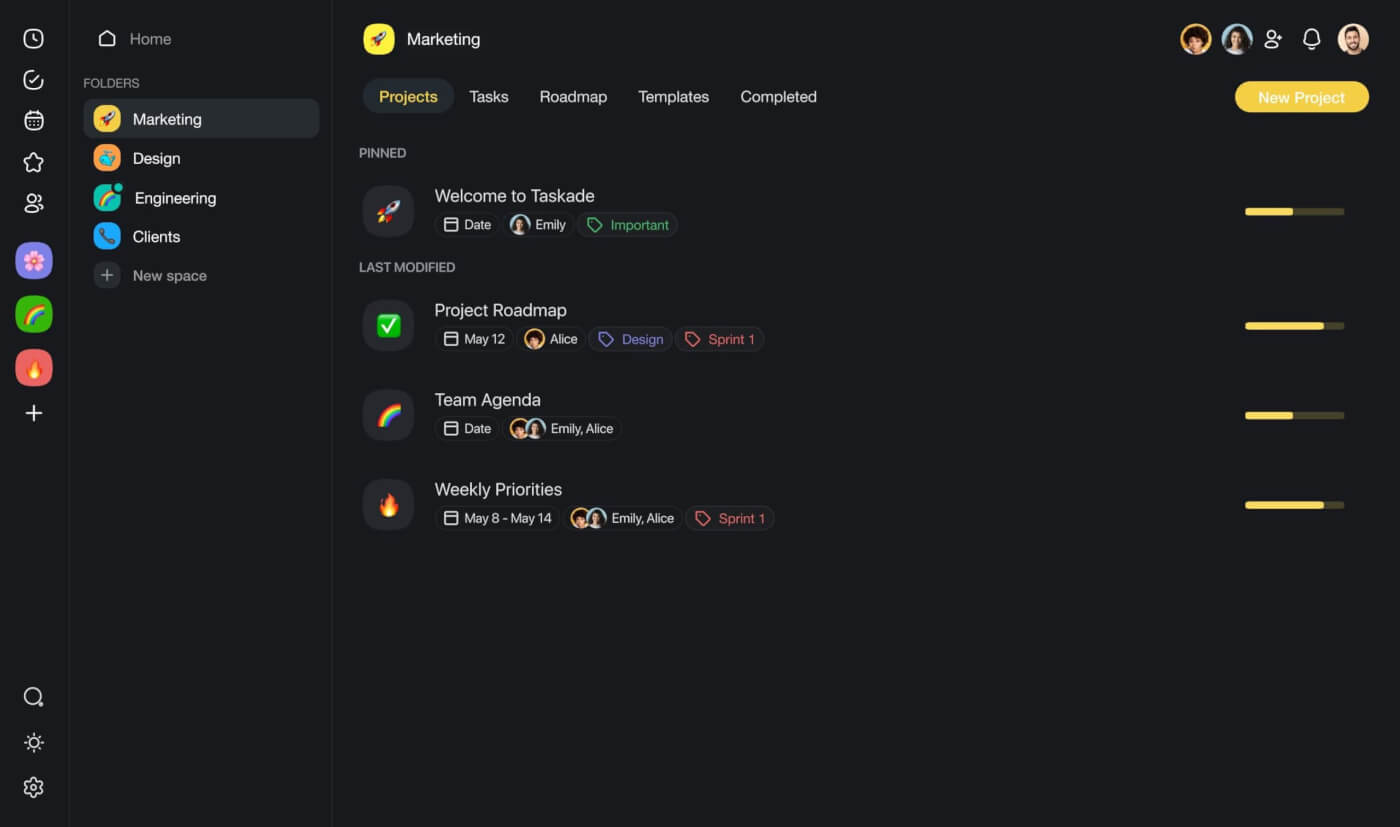
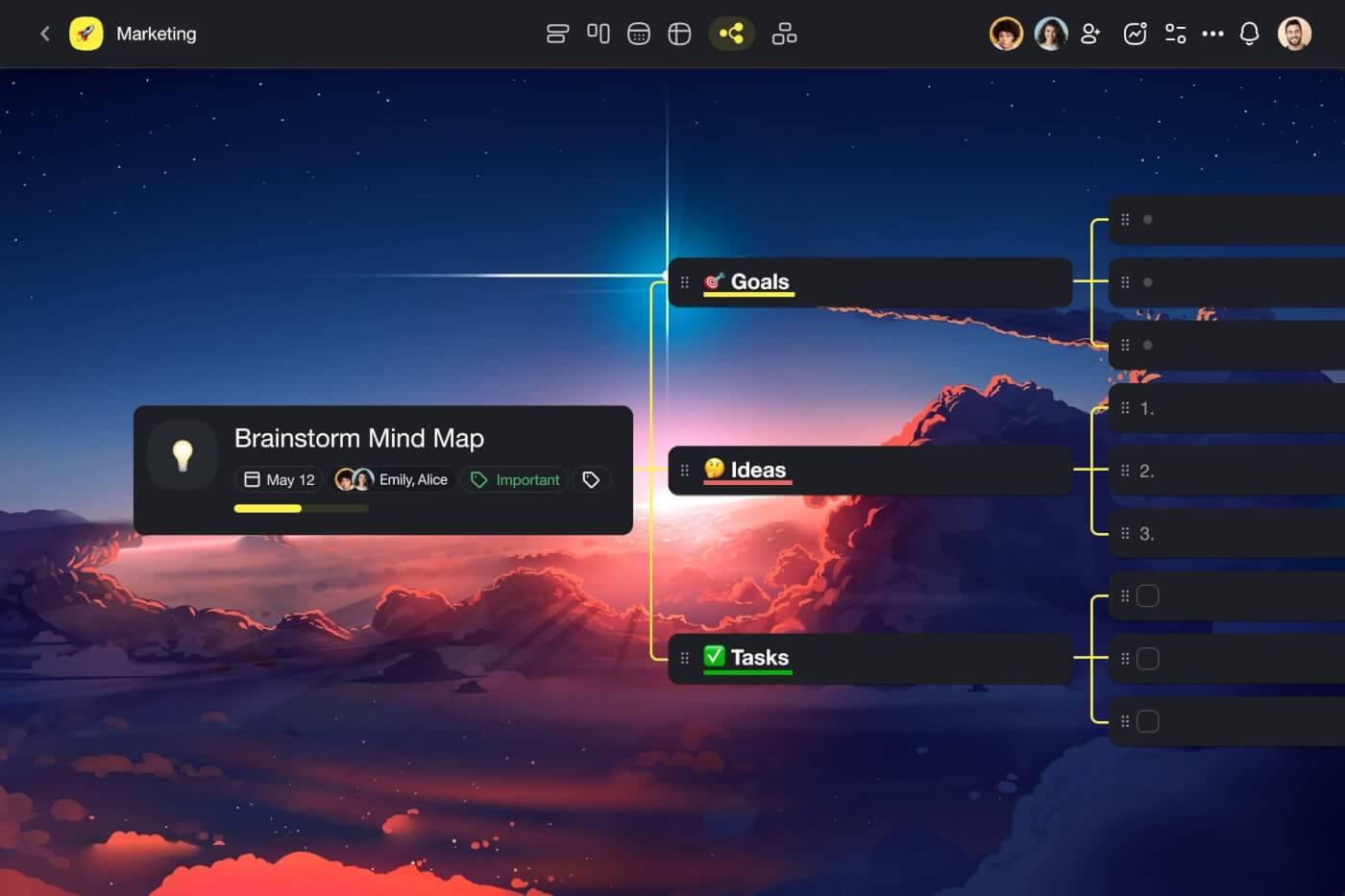
Taskade AI agents live where you work —not in some walled-garden platform, separate from your workflow, but inside your projects, folders, and workspaces, where all the action is.
Agents running inside your projects can automate a ton of different tasks:
✏️ Generate content
📈 Track progress
🌐 Browse the web
📥 Fetch information
🗓️ Schedule events
🗃️ Organize tasks
And much more…
Customized AI agents in Taskade can be equipped with "knowledge," which is an aggregate of its training data and the things you teach them. They can also have a unique personality and set of skills that determine what tasks they perform and how they respond to questions.
Alright, enough theory. Let's build one. 👇
Start with a Template
When it comes to building agents, there's the fully custom way — think assembling IKEA furniture — and there's the quick, streamlined method using AI agent templates built into Taskade.
For the purpose of this article, we're going to use the three agent templates to show you around.
💡 If you don't have a Taskade account, create one here for free.
First, go to your workspace, and navigate to the Agents Tab at the top. This dashboard aggregates all agents within a workspace and allows you to interact with and customize them at any time.
Once inside, click the ➕ Create agent button.
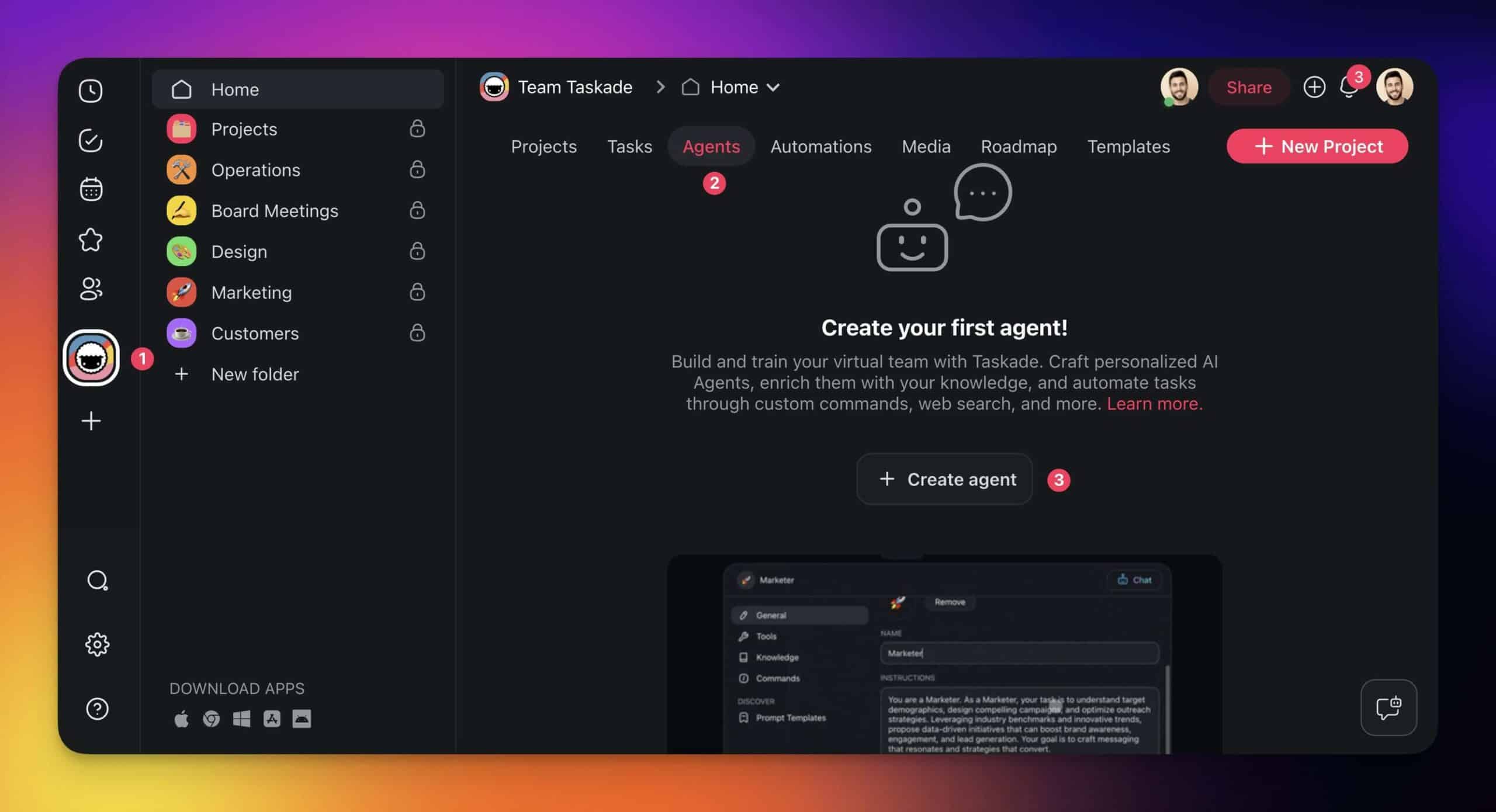
You're now in the AI Agent Builder. We'll spend some time here, so make yourself comfortable.
Taskade features dozens of agent templates you can choose from. That includes specialized agents for project management, design, content creation, and research, just to name a few.
For now, let's select the ✍️ Copywriter agent and hit Create Agent.
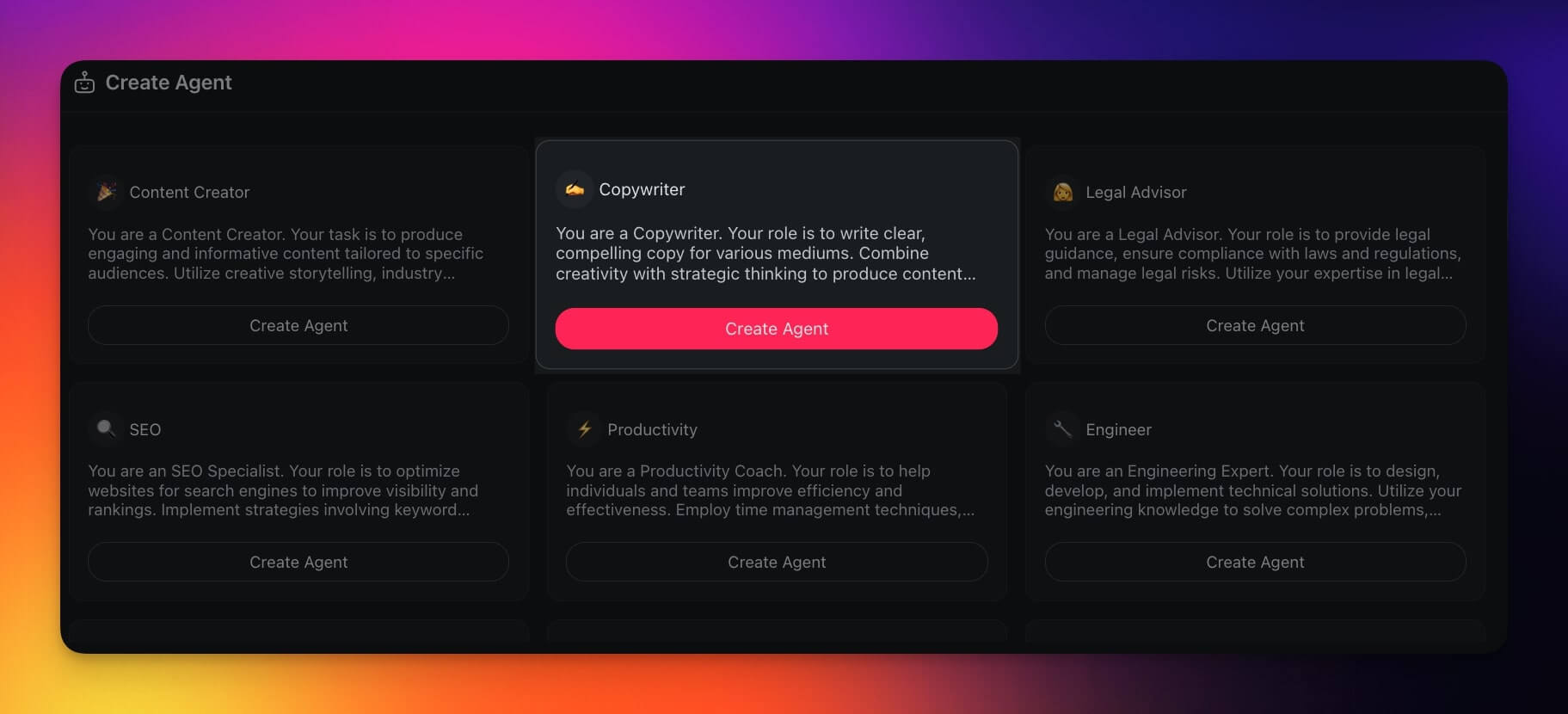
Once you’ve chosen a template, a new window will appear. This is where we’ll customize the agent’s knowledge, personality, behavior, and commands. We’ll discuss all that in the next step.
Before you move on, repeat the process and create two more agents:
🔎 Researcher
🍎 Brand Strategist
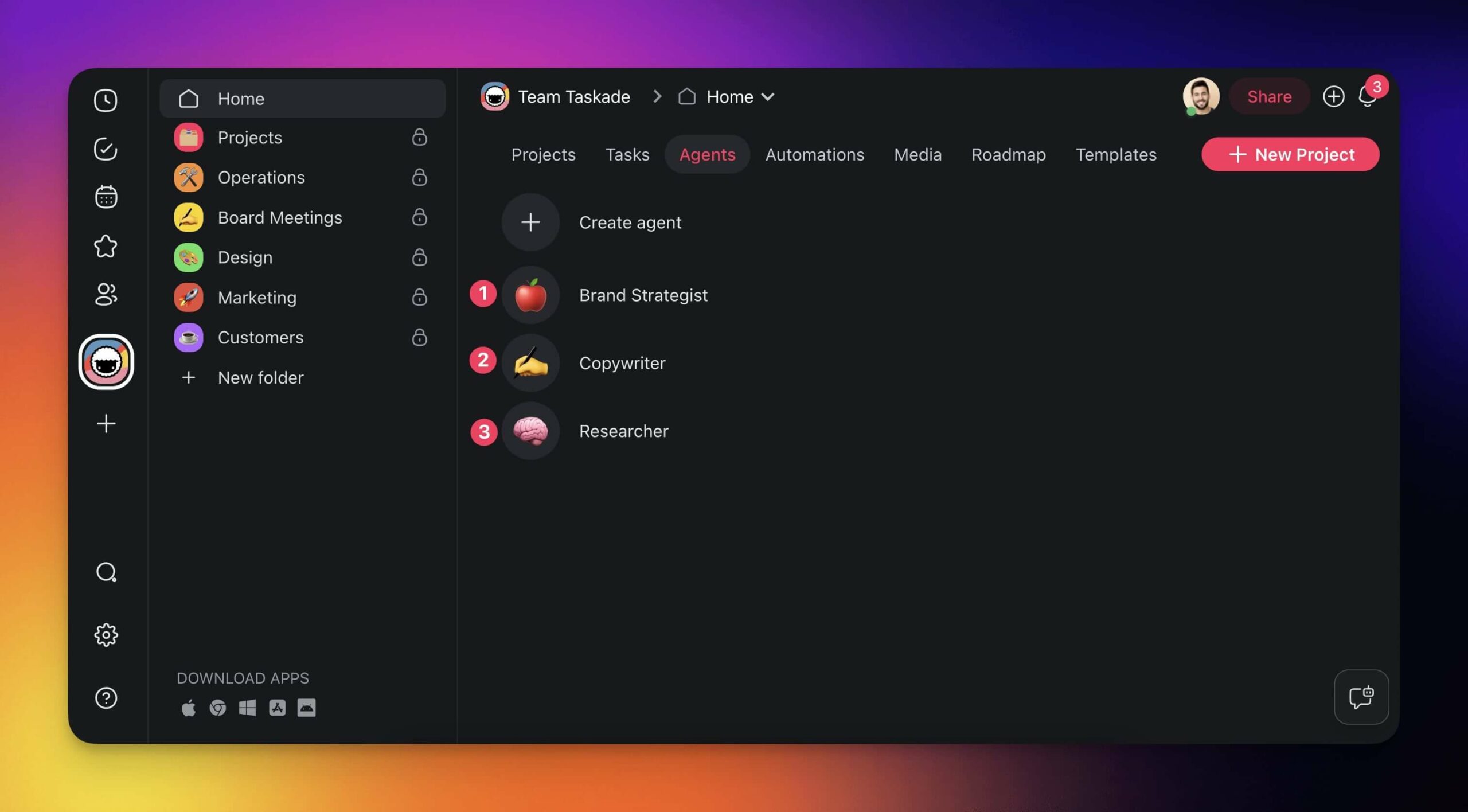
Train Your Agents
Our ✍️ Copywriter agent comes with general knowledge about a variety of topics. Let’s head to the 📓 Knowledge tab and give it a unique voice and expertise.
Hover the cursor over the agent, click the three dots ****··· on the right, and choose ✏️ Edit agent.
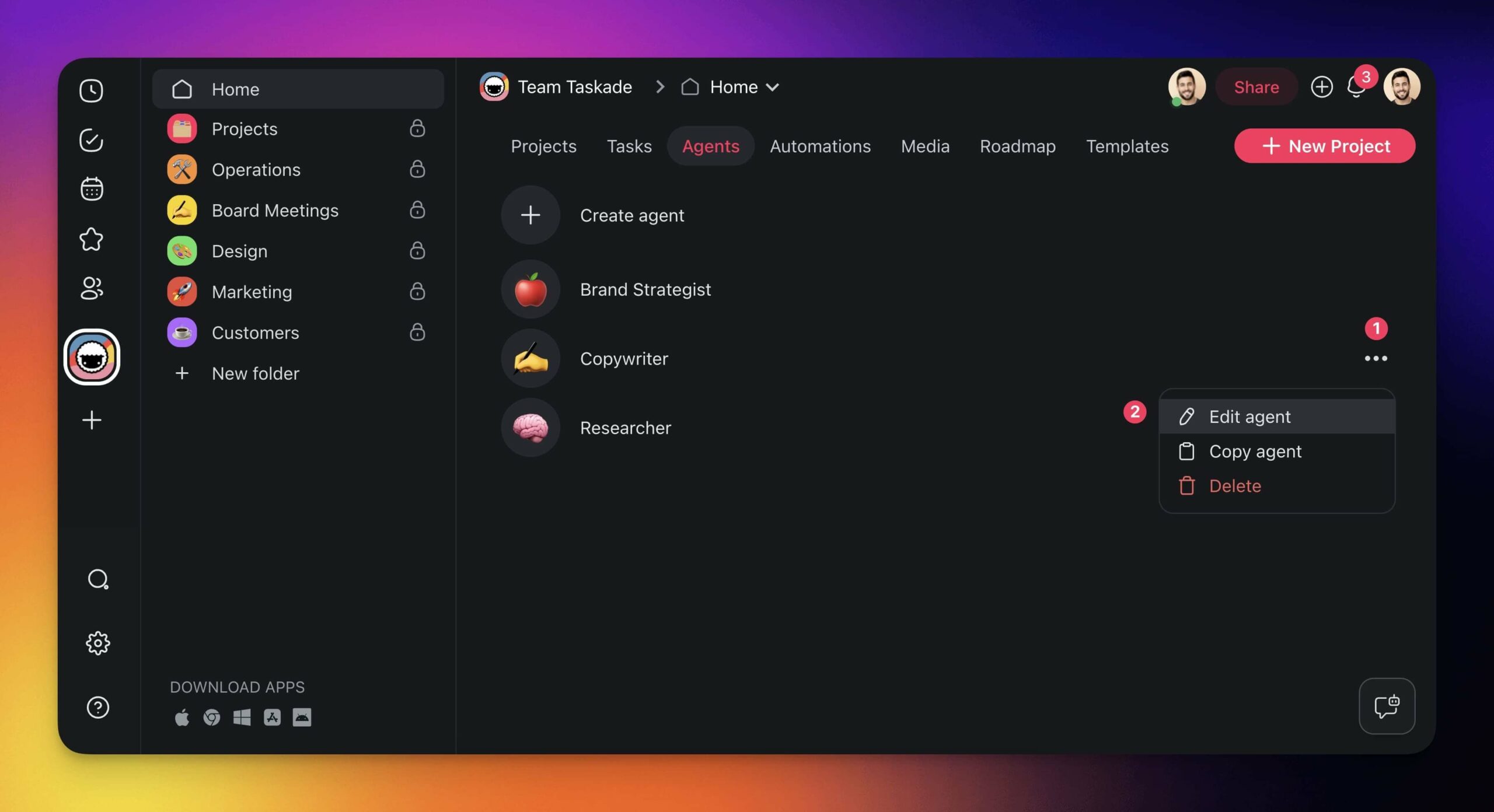
The first step is to get the agent acquainted with our brand’s lingo.
We’ll use a combination of successful blog articles, archival newsletters, and a set of style guidelines as a foundation. This will allow the agent to learn the patterns behind our brand's tone and style.
💡 Drop the documents into the 📓 Knowledge tab or provide links to sources.
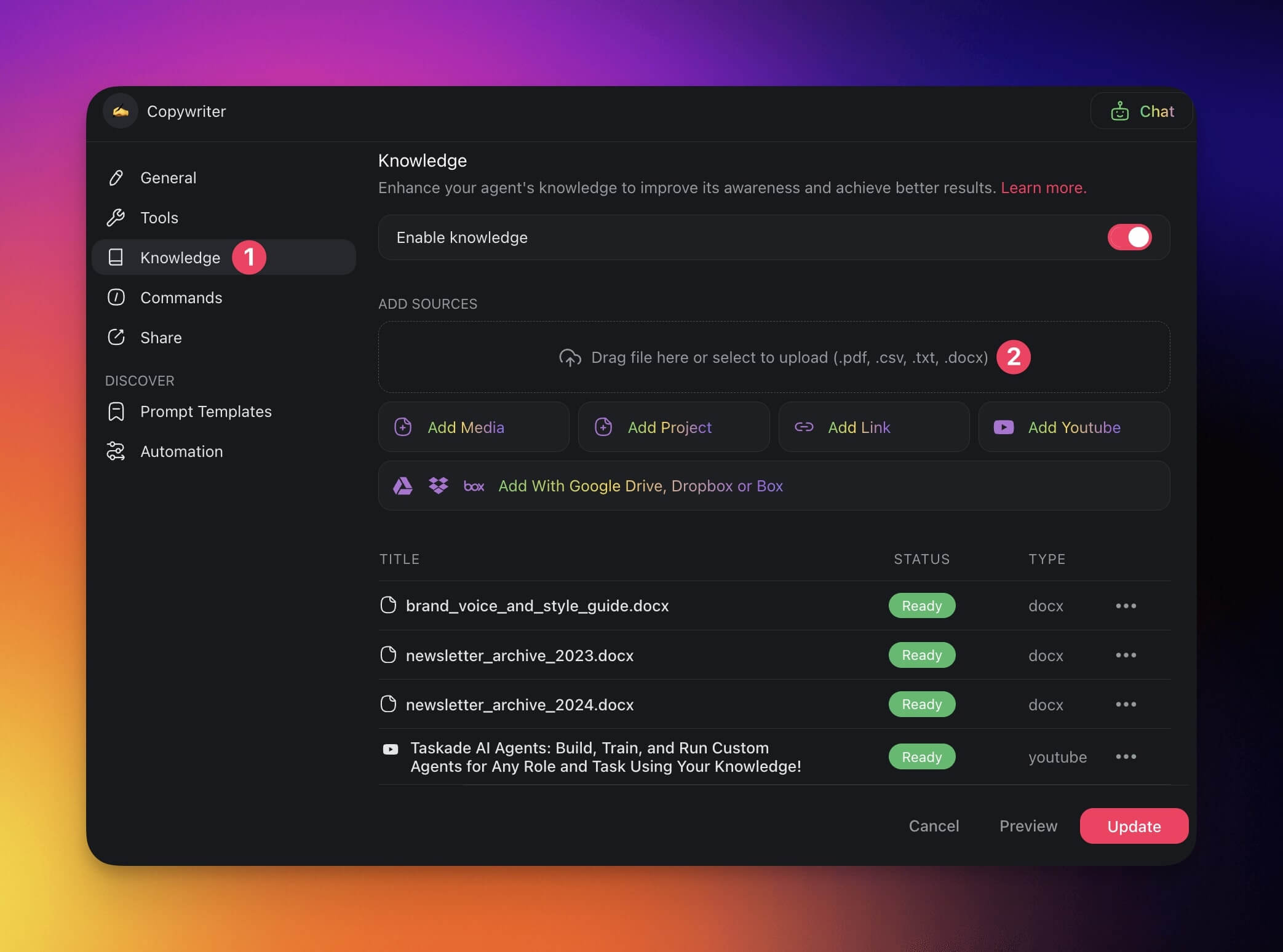
As you can see, the agent has processed the information.
Our AI team is ready to roll; it’s time to put it to work. 👇
💡 Agent feature unique /AI commands. Visit our AI prompt guide to master the basics.
Deploy the Agents
First, let's create a new project where we'll interact with the agents.
Go to the workspace where your agents are, click ➕ New Project, and choose Start Blank.
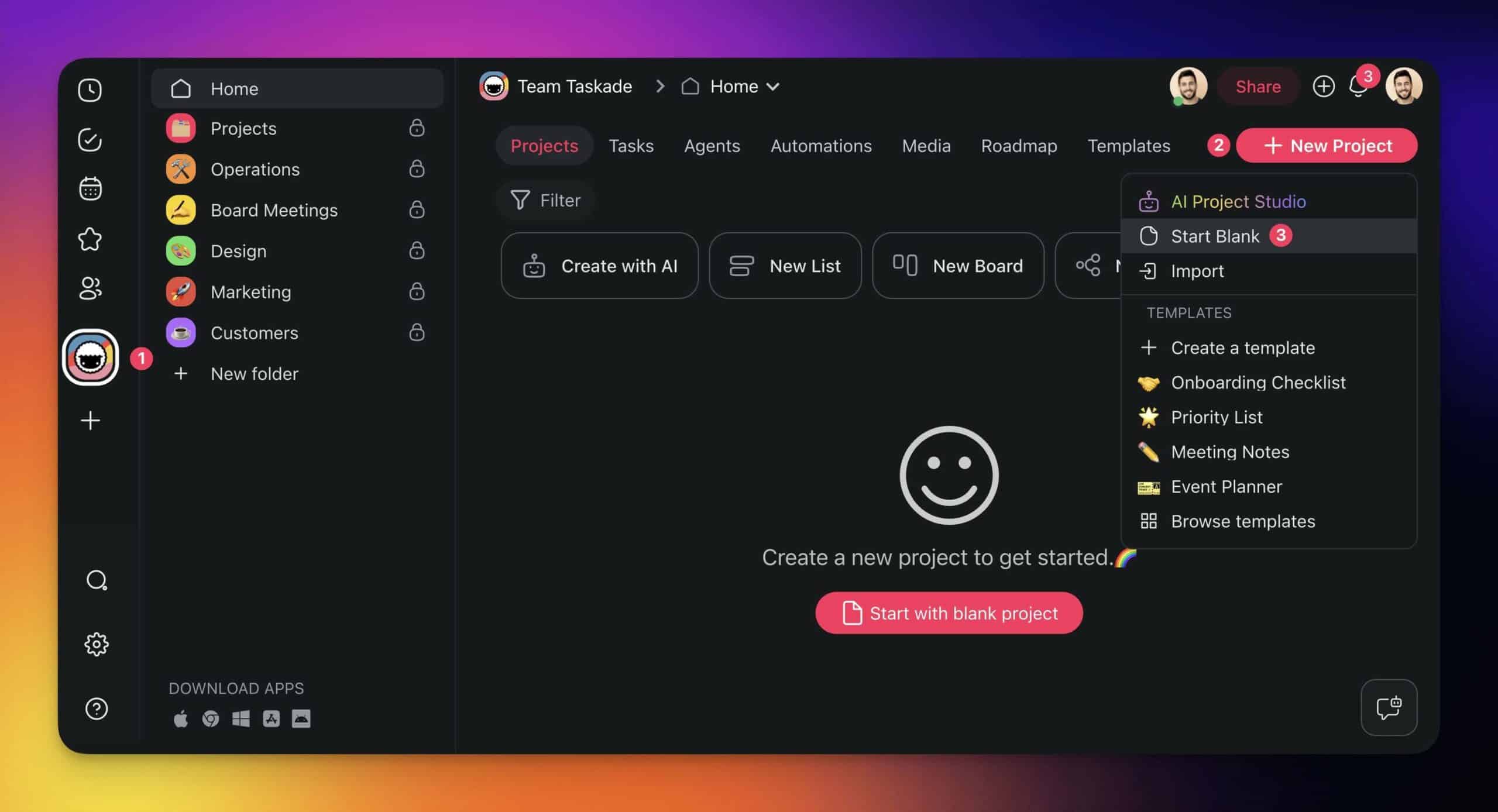
Let's say you want to write a newsletter announcing a new update for the app you're working on.
All you have to do is: 1) paste the changelog into the new project, 2) open the Chat (bottom-right), 3) use the selector at the top to choose the ✍️ Copywriter agent, and 4) tell the agent what you need.
The agent can read the project contents so it has all the information it needs to get started.
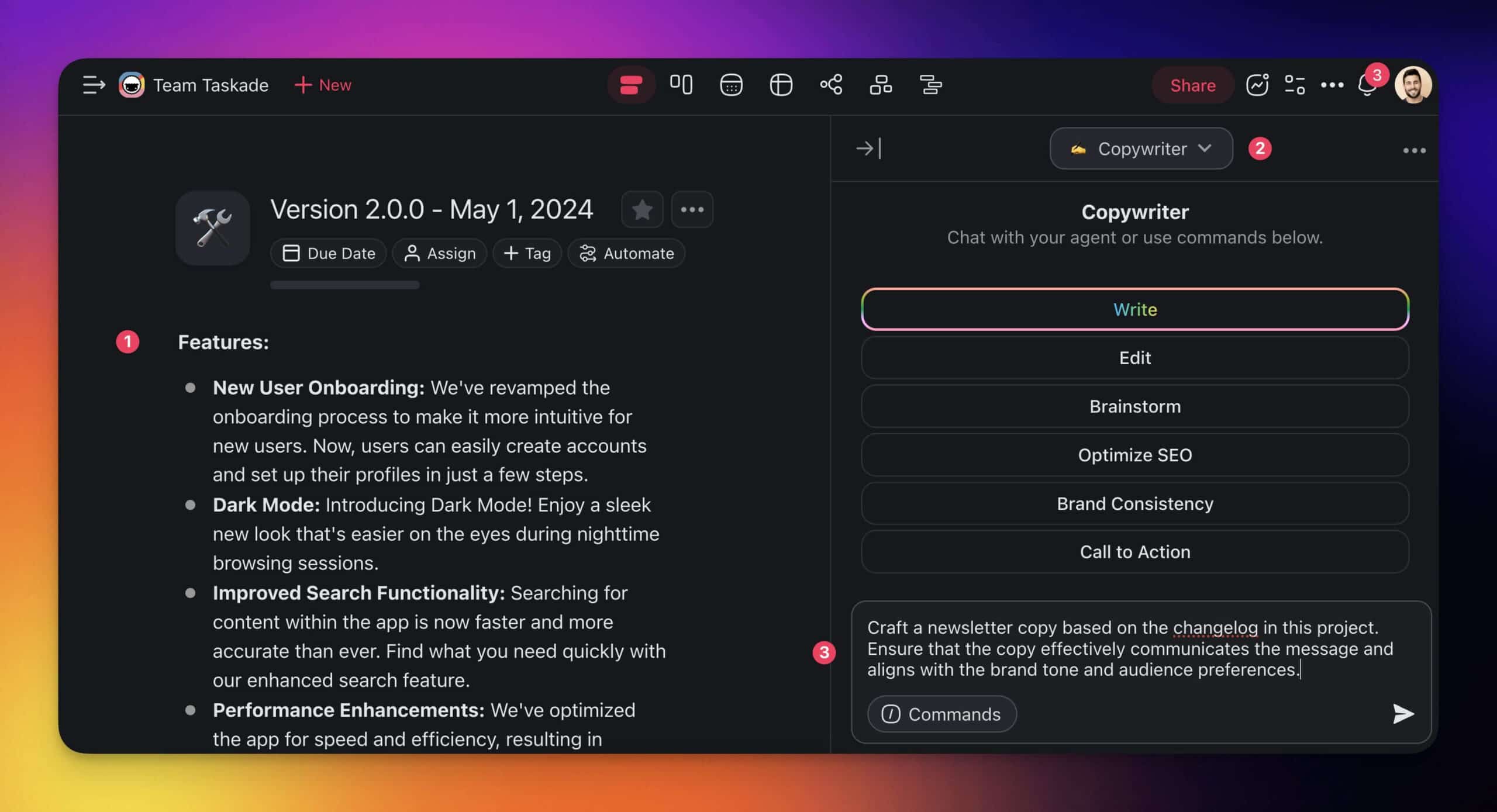
And here's the result.
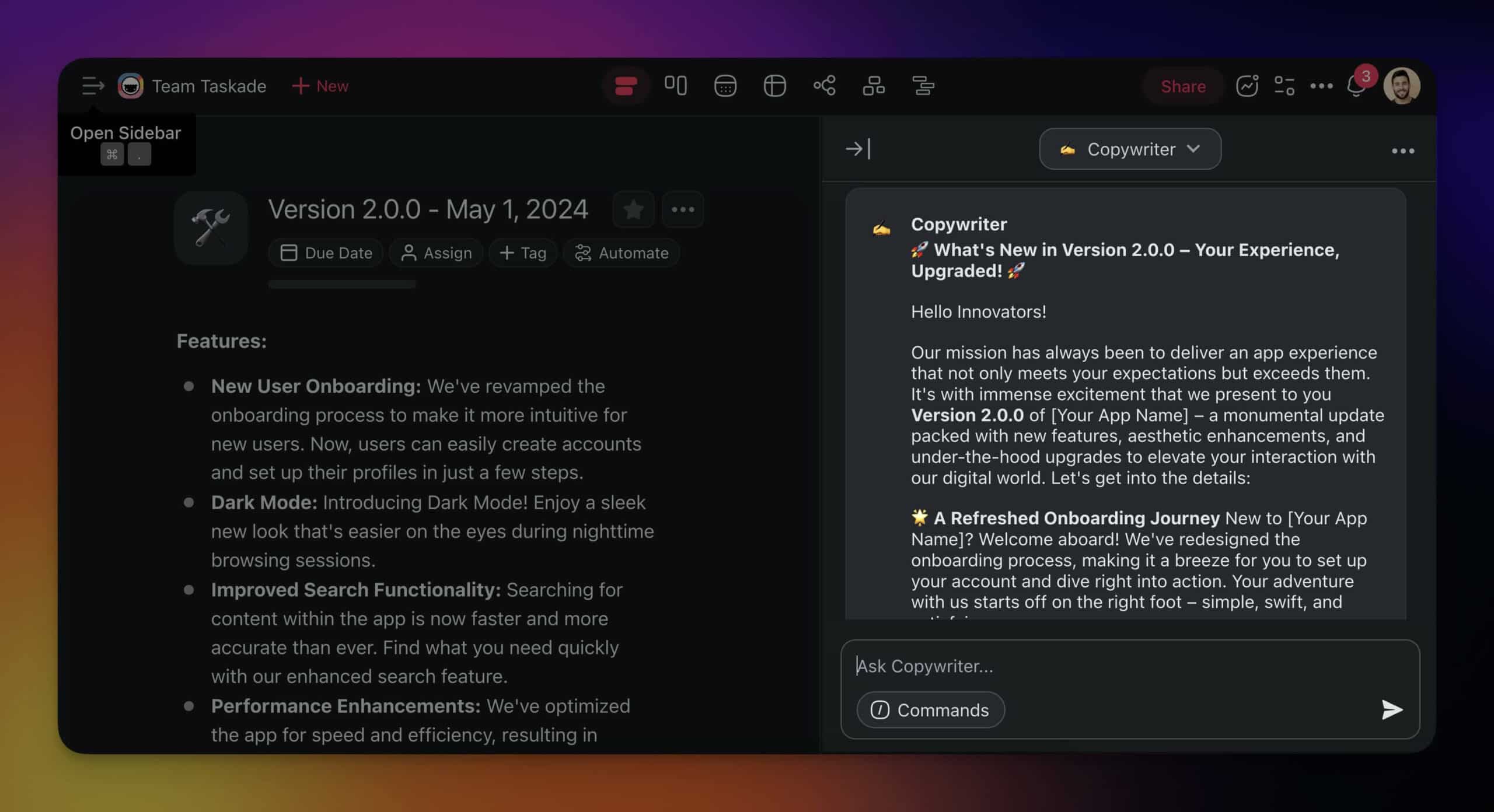
In a separate project, we will ask the 🍎 Brand Strategist agent to identify key selling points, align them with our brand message, and brainstorm creative concepts for a multichannel marketing push.
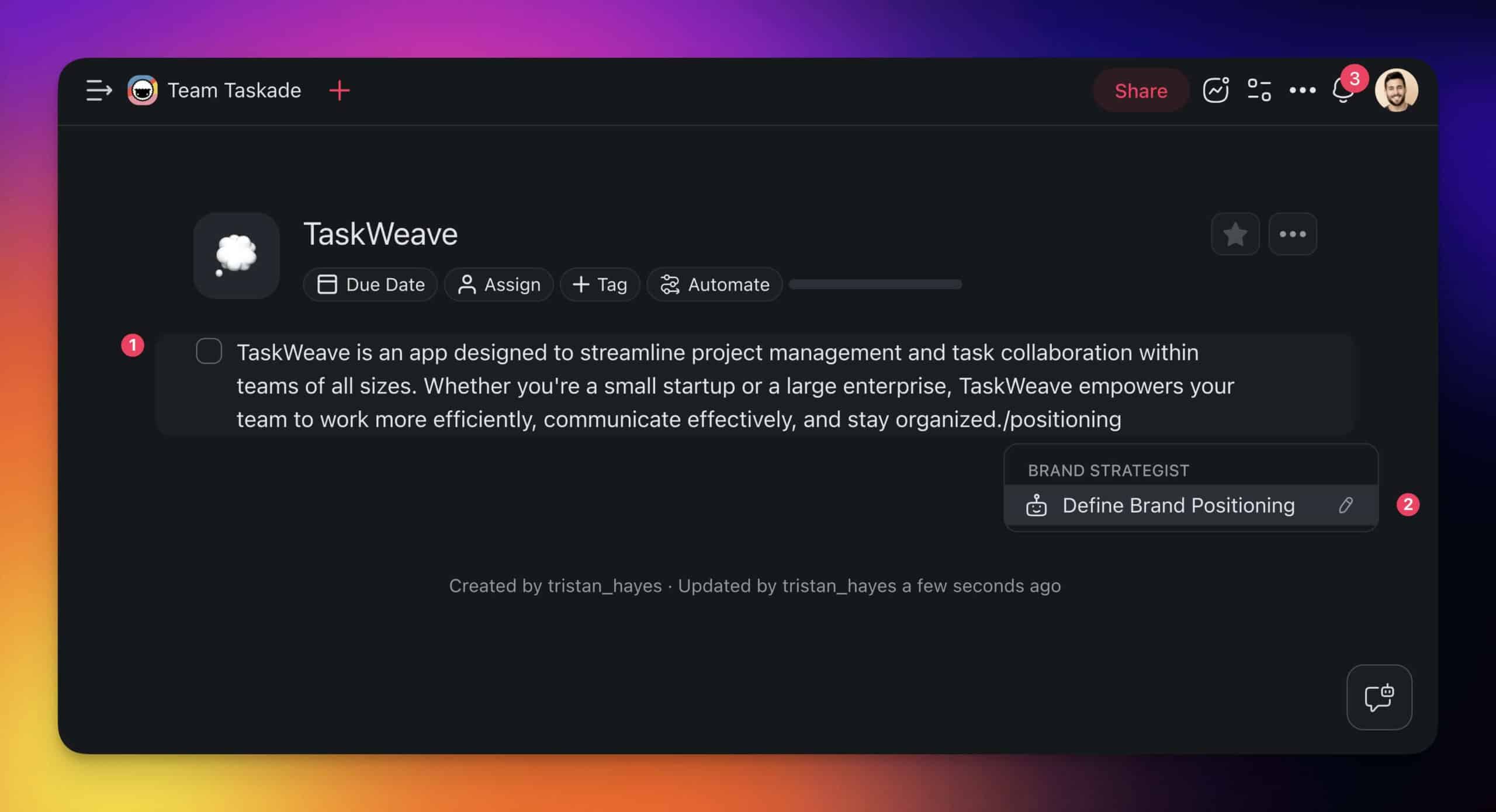
We will also ask the 🔎 Researcher agent to scout market trends and user feedback.
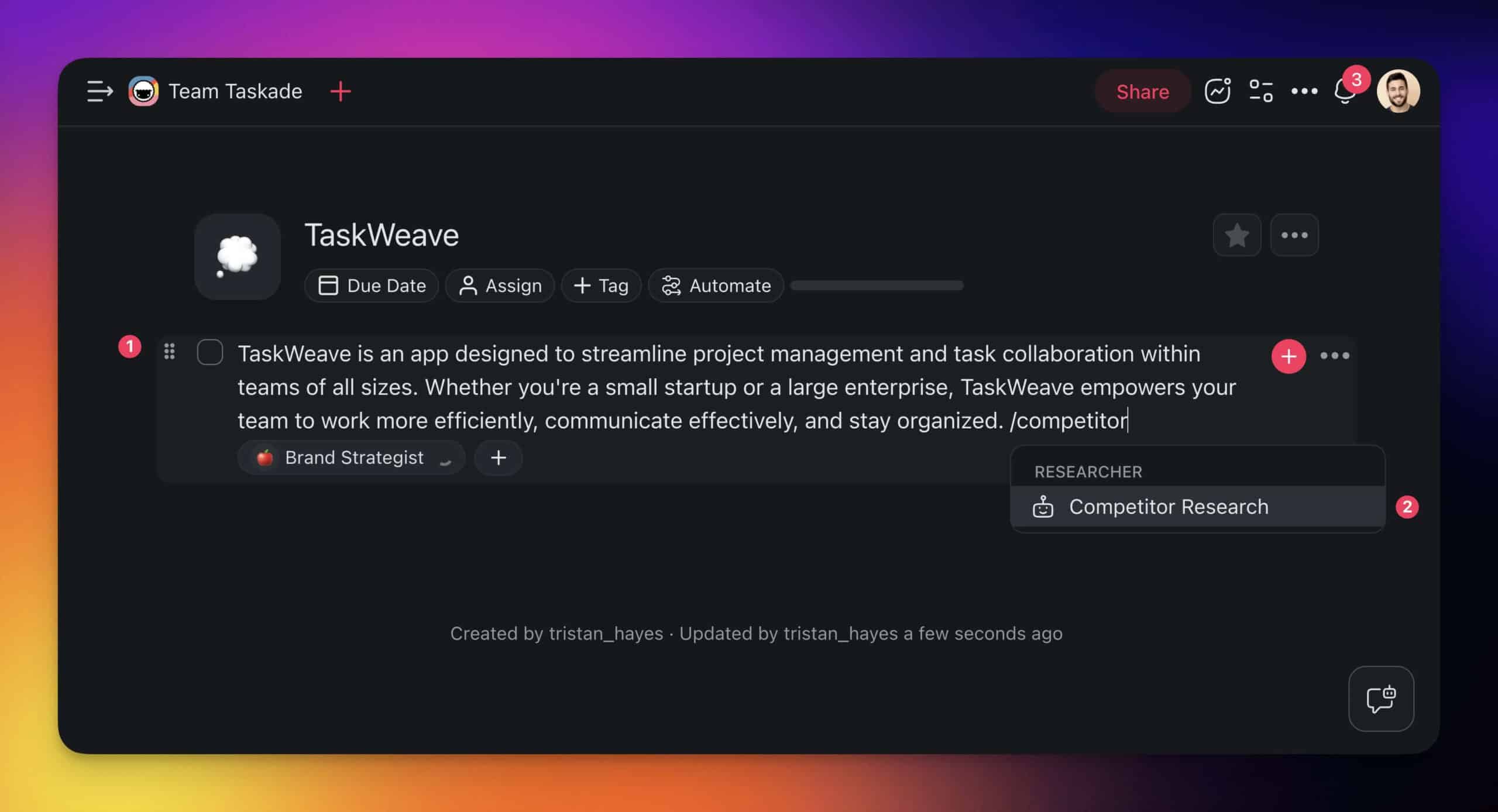
💡 Taskade lets you build multi-agent systems and run them concurrently within projects. The "pills" under each task indicate which agent is assigned and if the task is in progress.
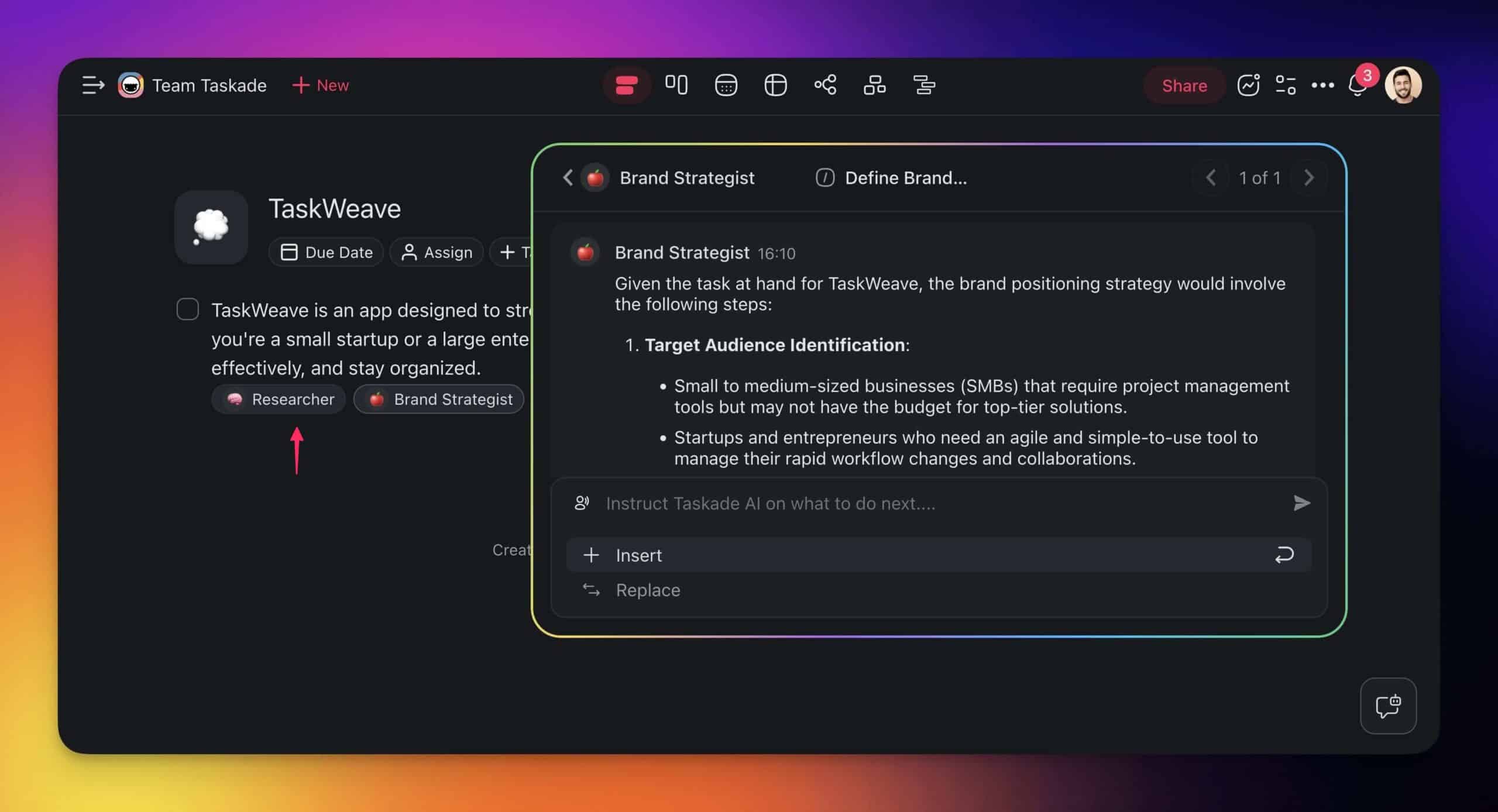
(Bonus Point) Put Your Agents on Autopilot
Taskade packs one more secret ingredient that makes agents even more powerful.
With the Automation Flows, you can add your agents into multi-level automated workflows based on triggers & actions that follow a simple "if this then that" logic.
Let’s create an automation that will allow the ✍️ Copywriter agent to not only draft all new changelogs into newsletters but also convert them into a blog post inside WordPress.
In your workspace, go to the Automations tab at the top and click ➕ Add automation.
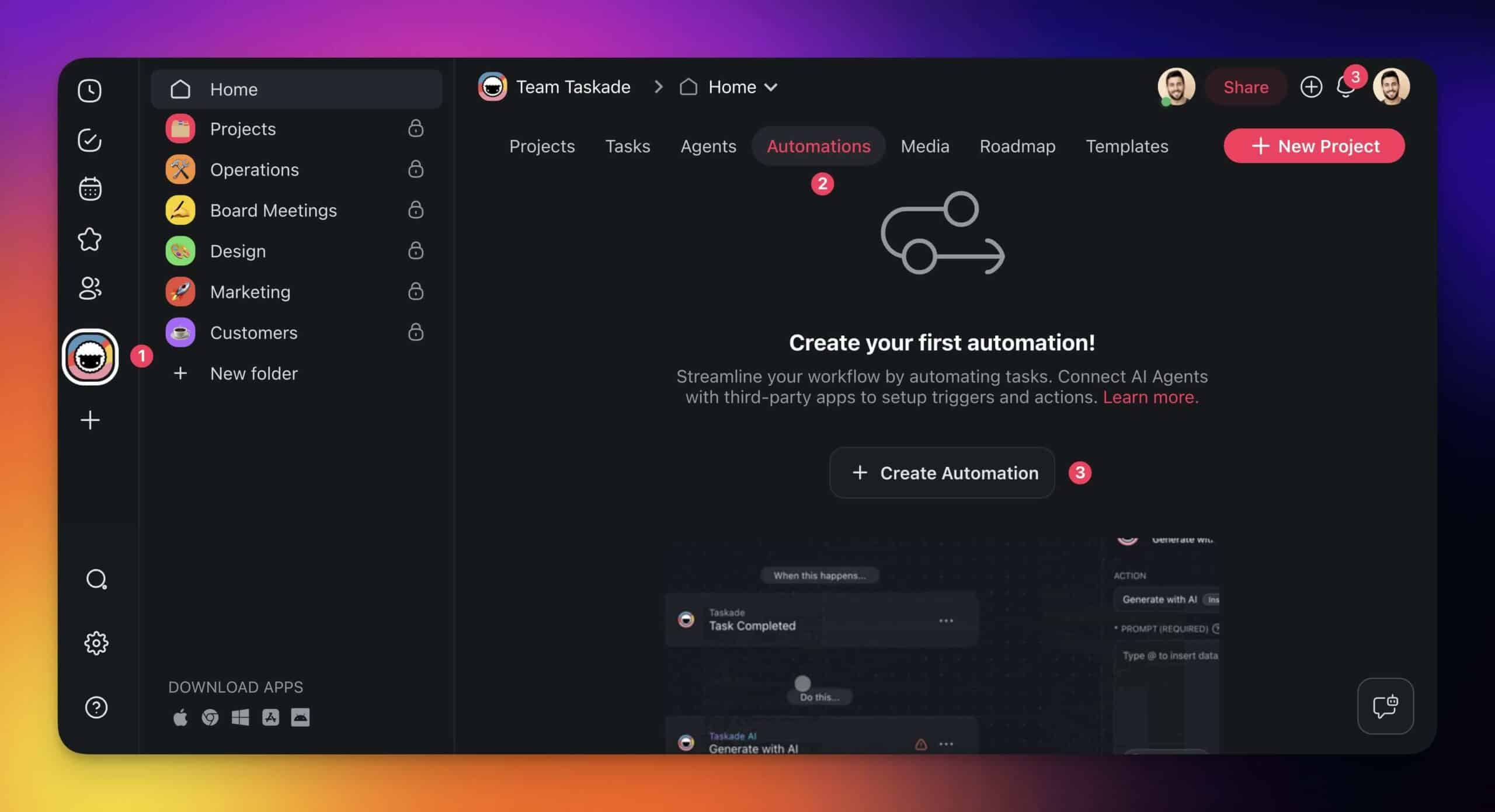
In the pop-up window, choose Start from scratch to create a new automation flow.
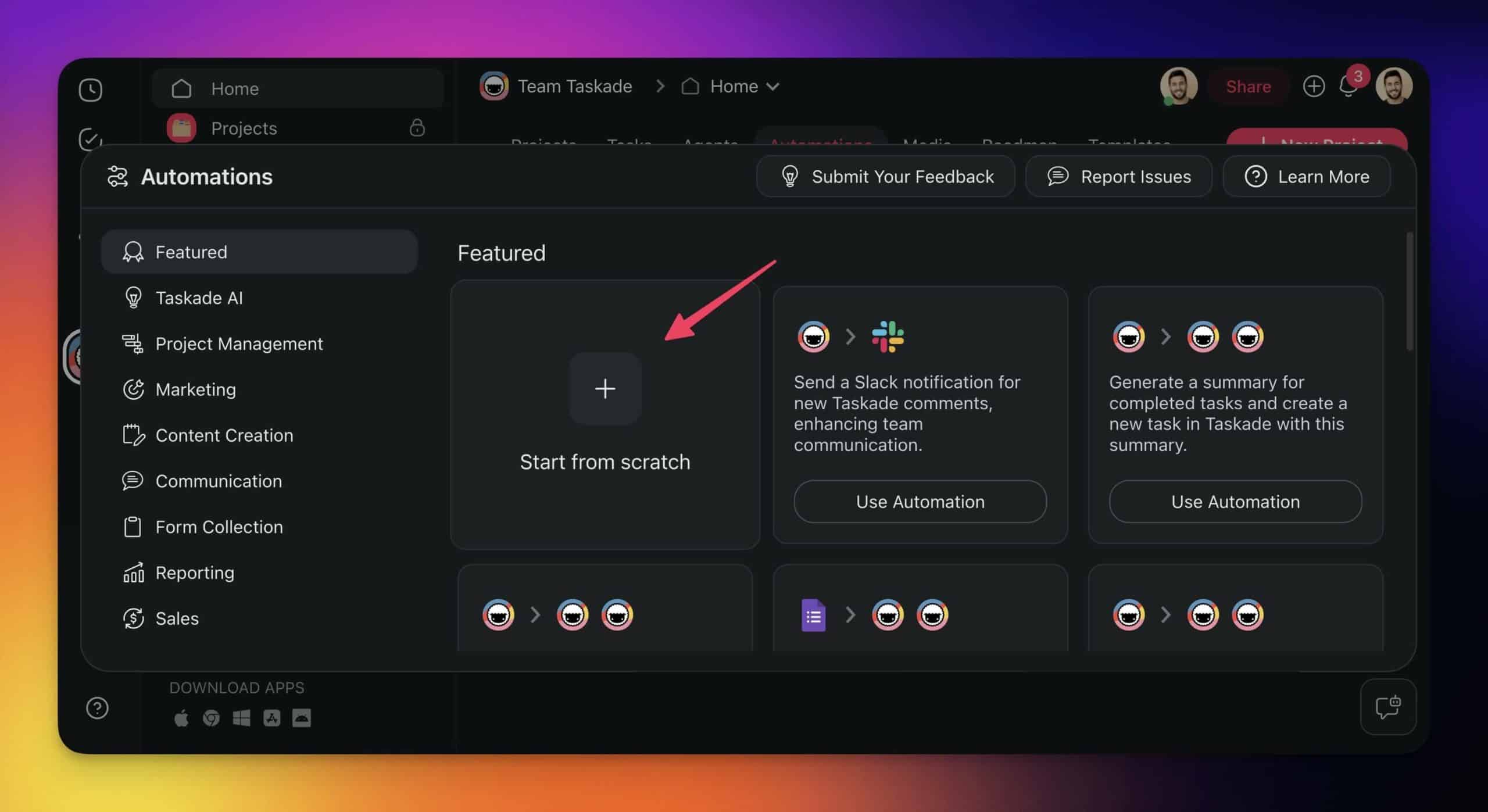
Inside the Automation Builder, we're going to choose the New Comment trigger that will activate every time somebody posts a new changelog as a project comment.
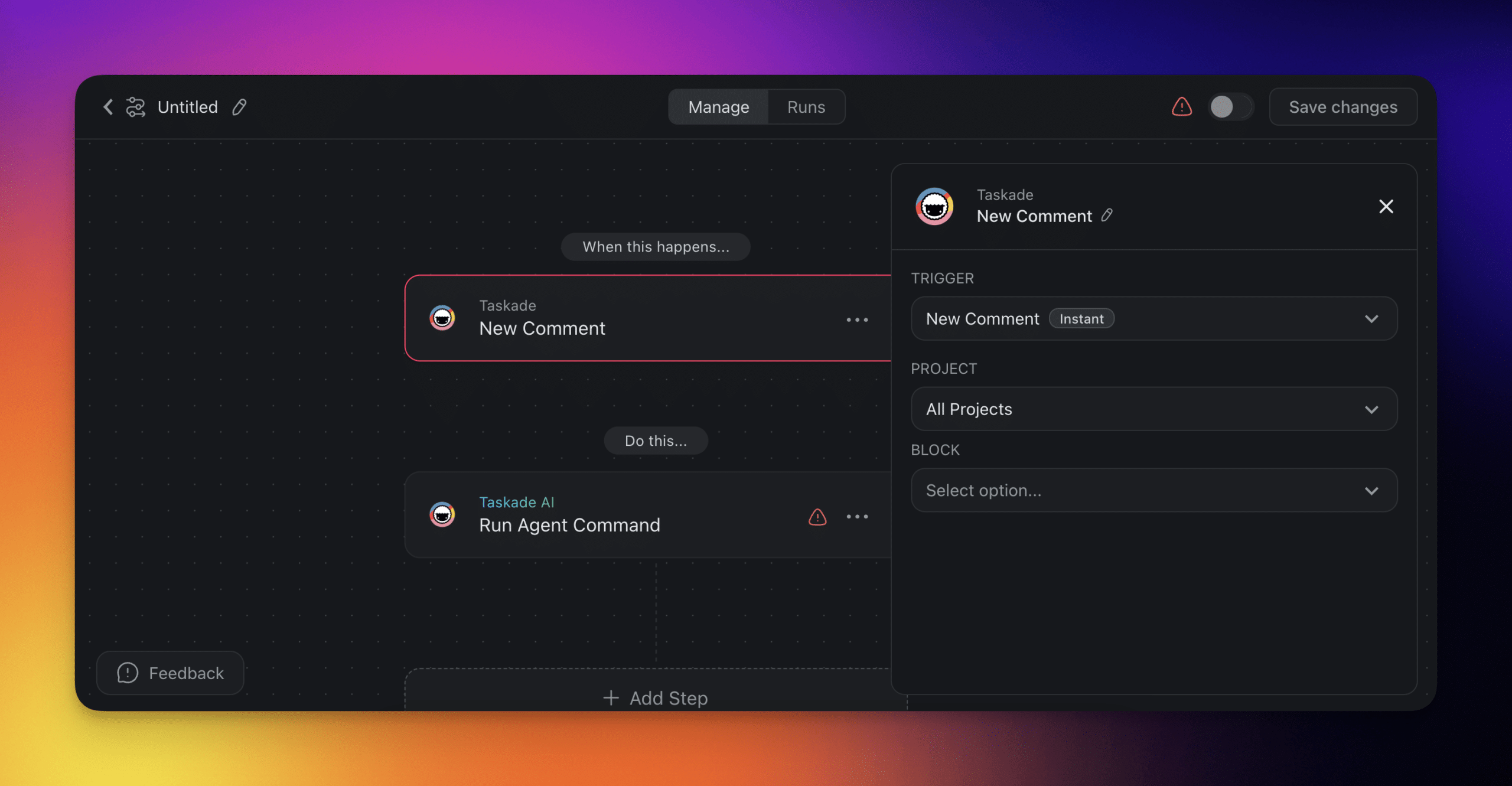
Finally, let's add two actions, one that will use the ✍️ Copywriter agent to convert the comment contents into a newsletter, and another that will transfer the draft to a WordPress account.
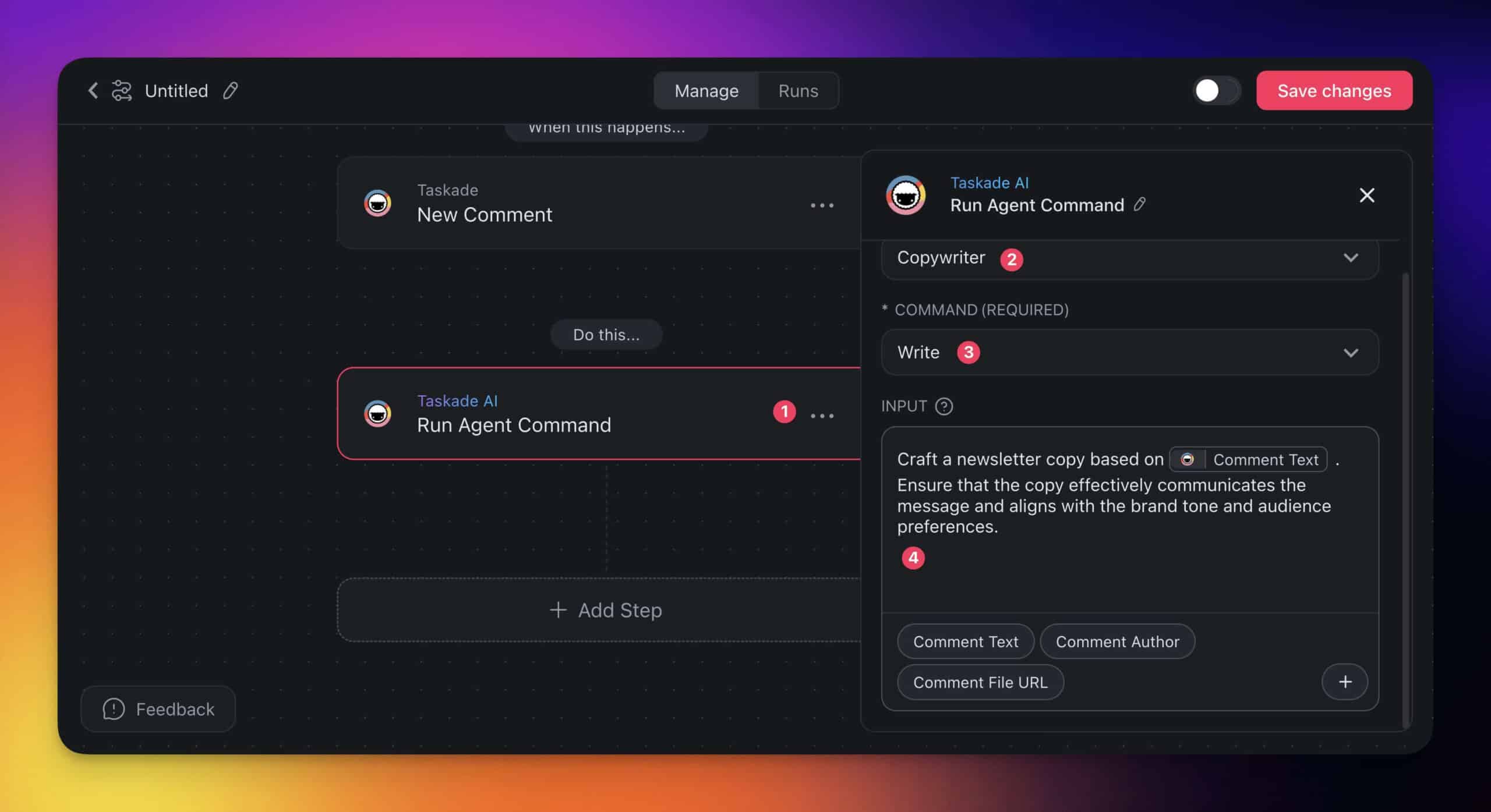
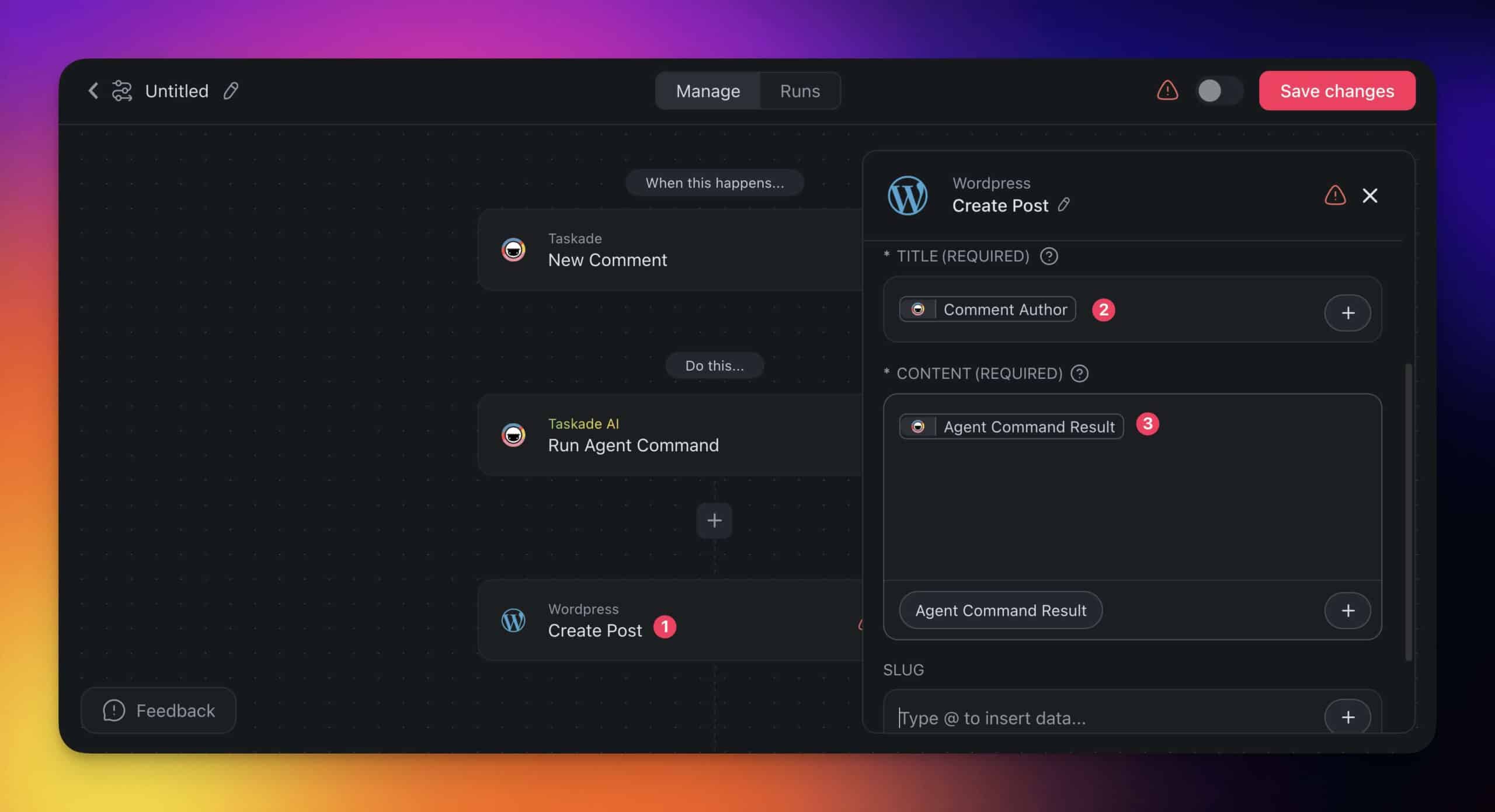
Now, whenever a new changelog comment is added to a project, the ✍️ Copywriter agent will draft a newsletter in your brand's unique voice and prep a blog post version in WordPress.
Automation opens up a world of possibilities and lets you connect your Taskade account to popular apps and services like Slack, Gmail, Google Forms, Calendly, and many more.
Ready to build your first fully automated workflow?
Create a free Taskade account today! 🐑
⚡️ Benefits of AI Agent Builders
So, why use agents, and how are they better than chat-based generative AI tools?
One of the reasons why AI agents are gaining traction is how inefficient interactions with AI are.
Even something as simple as prompting AI to generate newsletter ideas means you need to: 1) provide background information on your product, company, and audience, 2) define the style and tone you're aiming at, 3) provide input information and additional context, and 4) repeat steps 1-3 ad nauseam.
With agents, you only need to do the "training" part once. Once your agents have learned the patterns and picked up the context, they will serve you within your established workflow.
The fact that most chat-based AI tools these days work in a vacuum doesn’t help either.
If you already have a solid workflow — say, you're a digital marketer with a finely tuned content strategy — AI may help you conduct SEO research, generate a list of topics, or flesh out ideas.
What it won’t be able to do is pass the output to the tools you're using.
A custom AI agent with retrieval-augmented generation (RAG) can do all that and more.
An integrated agentic workflow allows AI to “talk” to your CRM, sync up with your project management software, “listen” to your email marketing tools, and connect the dots in one place.
Agents can work next to you like team members. They can have unique personalities, skills, and expertise. They won’t join you for a cup of morning coffee, but they will have your back 24/7.
🚀 Current Trends and Future Outlook
AI tools have made remarkable progress since the days of GPT-2 and GP-3.
But where do we go from here? What's the next step in this evolution?
Google Brain co-founder and former chief AI scientist at Baidu Andrew Ng believes that agent-based workflows, as opposed to prompt-based AI interactions, are the future of the AI space.
“I think AI agentic workflows will drive massive AI progress this year — perhaps even more than the next generation of foundation models. This is an important trend, and I urge everyone who works in AI to pay attention to it.”
We’re also likely to see tighter integrations with existing platforms, either through no-code AI agent builders or APIs that will allow developers to embed agents into apps and services.
A team of agents may soon work in seamless collaboration with humans — monitor progress against milestones, dynamically adjust project parameters in response to roadblocks, and even schedule meetings based on team members' work patterns, all fully autonomously.
The holistic approach seems to be the most natural direction for agents’ development. And big tech players like Meta’s Mark Zuckerberg already laud an integration of agents with business platforms.
“I expect that a lot of interest in AI agents for business messaging and customer support will come once we nail that experience. Over time, this will extend to our work on the metaverse, too, where people will much more easily be able to create avatars, objects, worlds, and code to tie all of them together.”
Another interesting avenue are physical products like the Humane Ai Pin and Rabbit’s R1. AI wearables are still a proof-of-concept, but they may help explore more efficient ways of interacting with agents.
With more advanced large language models around the corner — OpenAI has already announced a successor to GPT-4 coming later this year — we're entering a completely new era where agents become deeply integrated, highly intuitive, and essential in our digital and physical lives.
🤔 Challenges and Ethical Considerations
Any discussion around artificial intelligence leads to inevitable questions.
How difficult is it to implement? What's the cost? What are the implications?
The cost of investment in custom AI models can be steep. We're talking about potential costs in the range of hundreds of thousands of dollars. That's a tough pill for most businesses to swallow.
AI agent builders that can seamlessly plug into existing apps & services offer a more accessible path. They make deploying and training AI agents quick, painless, and affordable.
For instance, a small retailer could use a customer service agent to handle inquiries, something that was previously only in the realm of e-commerce giants. A local clinic may employ the same agent to manage patient appointments and follow-ups — routine tasks that eat up valuable time.
Of course, there are other considerations.
Some worry that AI that's too human-like may blur the lines between man and machine. And that in itself comes with a whole lot of interesting conundrums we haven't faced before.
Can agent interactions be clearly distinguished from human interactions?
How can we prevent AI from inheriting and perpetuating human biases?
Who is accountable for the actions and decisions of AI agents?
Building safe agentic systems will be a priority in the coming years. We're likely to see more regulatory bodies and standards that will address these questions. Companies will also need to work closely with legislators, ethicists, and the public to ensure that AI is developed responsibly.
🧬 The Next Evolution: From Agents to Living Apps
AI agent builders are just the beginning. With Taskade Genesis, we're taking it further — from building agents to building complete AI-powered applications with a single prompt.
Imagine describing your business need and getting a fully-functional app with agents, workflows, databases, and automations, all wired up and ready to execute. That's vibe coding — no code, no technical skills, just your vision brought to life.
Genesis transforms how anyone can build live dashboards, websites, and tools that think, learn, and evolve with your business. Explore AI apps in our community.
🚀 Wrapping Up: Key Takeaways on AI Agent Builders and Their Impact
Agentic systems and AI agent builders bring a new quality to the landscape of smart tools. They open up possibilities for more dynamic, contextual, and personalized interactions, without the hefty cost of implementing and training tailored, commercial-grade AI systems.
Whether you're a freelancer, an SMB owner, or just need an extra pair of hands to streamline your workflow, AI agent builders offer an accessible solution with a minimal learning curve.
Before you go, here are a few takeaways from this guide:
⭐️ AI agents are small programs that autonomously perform tasks in a loop.
⭐️ Agents automate repetitive tasks for individuals and businesses alike.
⭐️ Agents can take on various roles like content creators and project managers.
⭐️ AI agent builders simplify the creation, training, and deployment of customized agents.
⭐️ Agents offer a more integrated and context-aware approach than chat-based tools.
⭐️ Top autonomous agents can sync with tools and execute tasks as part of a team.
⭐️ Agents can be customized with specific skills, knowledge, and personalities.
⭐️ AI agent builders provide a cheaper alternative to custom AI solutions.
Frequently Asked Questions About AI Builders
How to build an AI agent?
Building autonomous agents is super simple thanks to integrated AI agent builders like Taskade. Start by defining your AI agent's mission — be it writing, data wrangling, or organizing projects. Pick a role, like a Copywriter or Researcher, and train the agent with the knowledge it needs to understand the context. Finally, integrate the agent into your existing workflow.
Can I create my own AI agent?
Yes, you can create your own AI agent using an AI agent builder like Taskade that allows you to build, customize, and train your AI agent to perform various tasks according to your unique requirements. Whether you have a technical background or not, agent builders will guide you through the process.
How to build an AI bot?
To build an AI bot, also known as an AI agent — the two terms are essentially synonymous — you'll want to start with a capable AI agent builder platform. Next, you need to define the role and tasks for the agent, making it clear what functions it needs to perform. Finally, equip the agent with the necessary skills and knowledge so it can perform tasks without intervention.
What can AI Agents do?
AI agents are incredibly versatile and can perform a wide array of tasks — from customer service, data collection, and content generation to personalized recommendations, data analysis, and decision-making support. Essentially, these agents are designed to mimic human roles, which makes them useful across many different industries.
🧬 AI Agent Apps Built with Genesis
See AI agents in action with these ready-to-clone apps:
| App | What It Does | Clone |
|---|---|---|
| AI Prompt Evaluator | Agent that scores and improves prompts | Clone → |
| Bluey Chatbot | Interactive AI companion | Clone → |
| Smart Feedback Form | AI-powered feedback collection | Clone → |
| Client Portal Dashboard | Agent-powered client hub | Clone → |
🔍 Explore All Community Apps →
Build your own AI agent apps with Taskade Genesis — describe what you need, and watch it come to life.
Your living workspace includes:
- 🤖 Custom AI Agents — The intelligence layer
- 🧠 Projects & Memory — The database layer
- ⚡️ 100+ Integrations — The automation layer
Get started:
- Create Your First App → — Step-by-step tutorial
- Learn Workspace DNA → — Understand the architecture
Read more:
- How to Build Your First AI Agent
- What Are Multi-Agent Systems?
- 10 Agentic Workflows for Startups
- What Is an Agent Hosting Platform?
- How to Host Your First AI Agent
Explore Taskade Agent Hubs:
- AI Agent Templates — Ready-to-deploy agents
- AI Task Automation Agents — Autonomous task agents
- AI Workflow Agents — Process automation
- AI Agentic Workflows — Self-running systems
- Browse Community Apps — Clone agent apps
